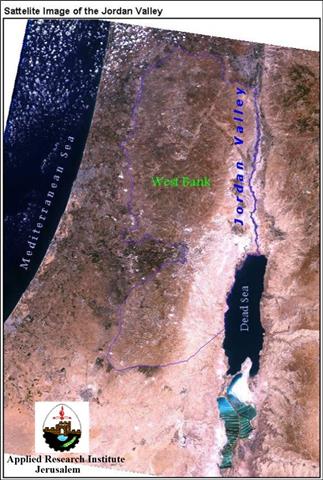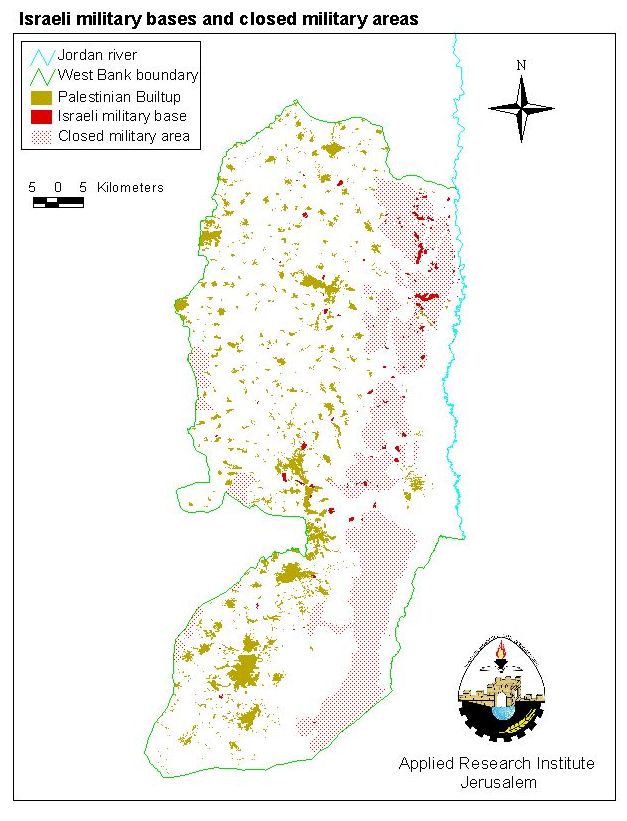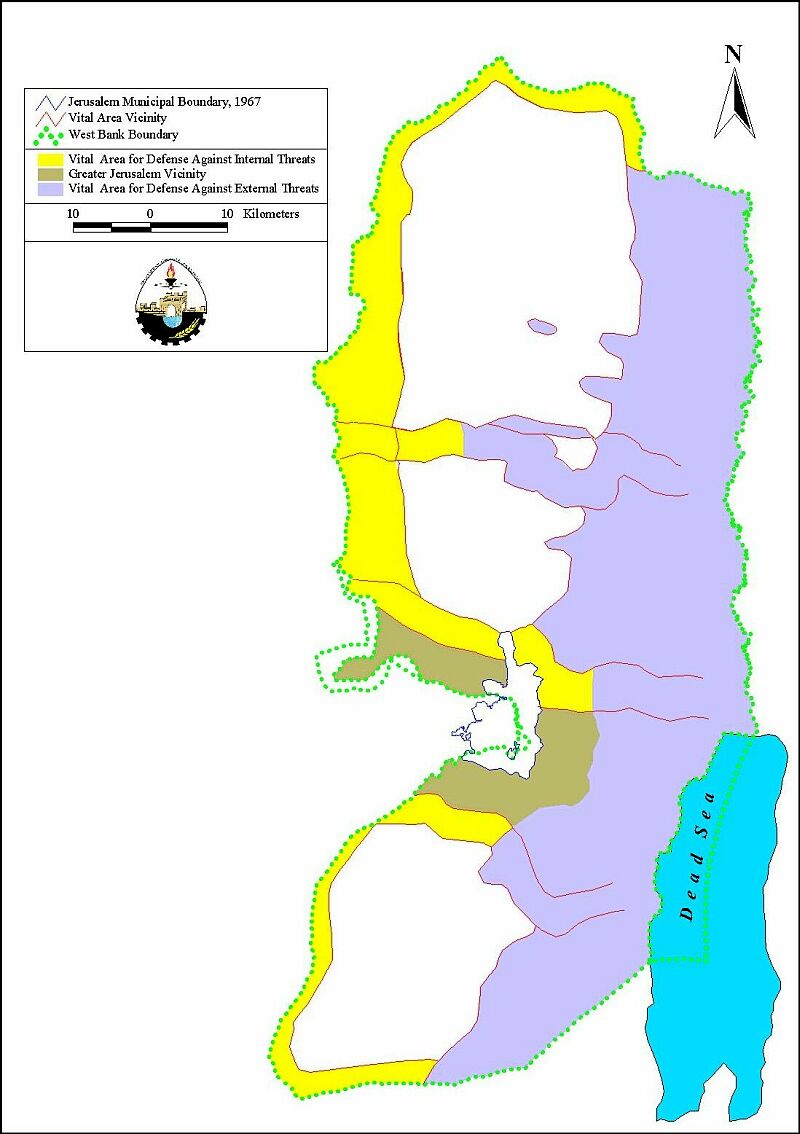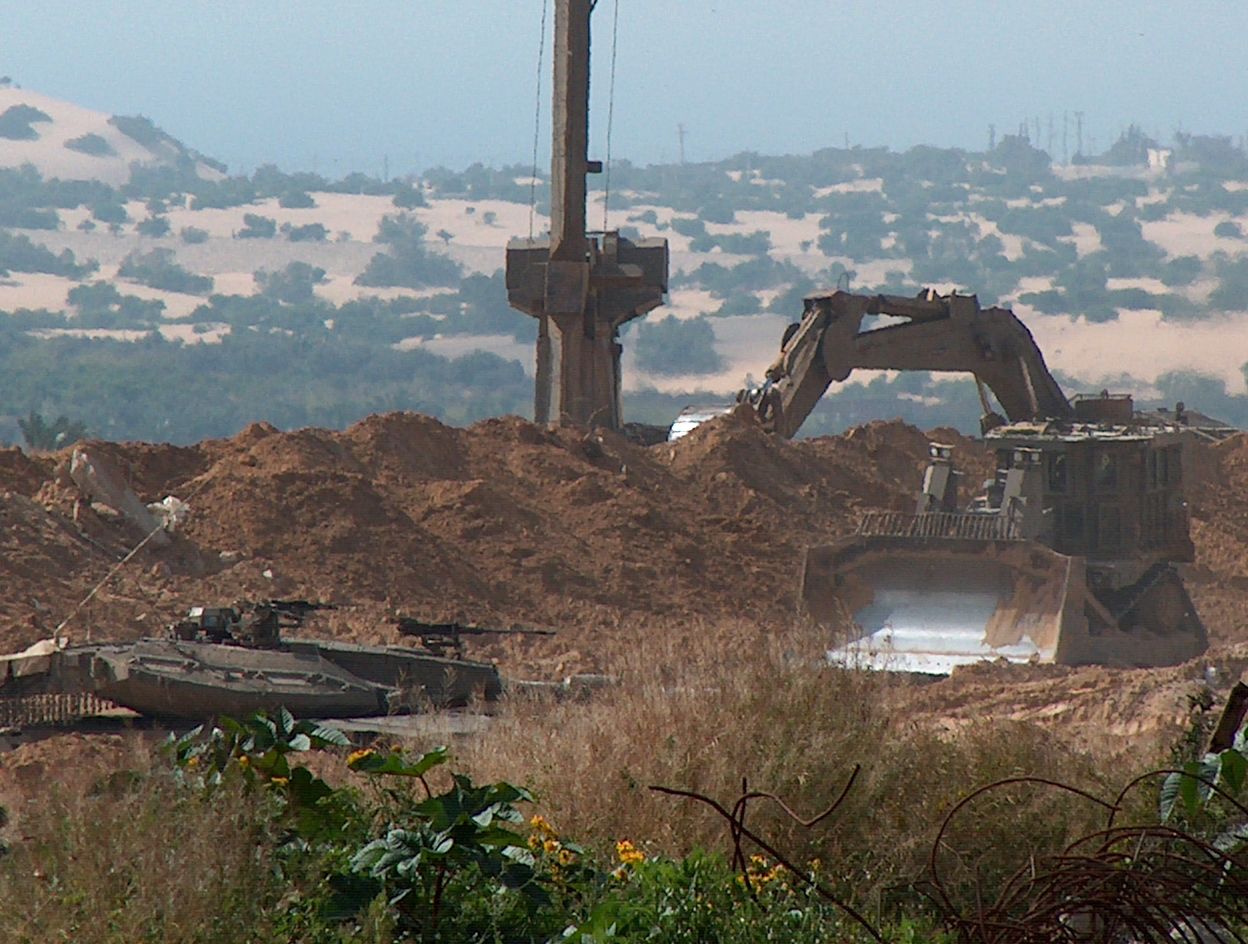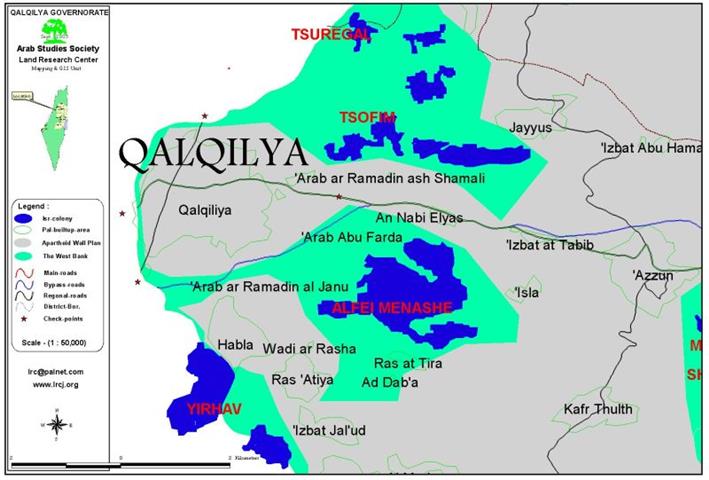The Jordan Valley is a geographical feature formed around the River Jordan. Part of it lies in the West Bank and is enclosed between the mountains of the West Bank to the west and the River Jordan to the east; See Map 1.
Map 1: Satellite image of the Jordan valley.
It is rich in water resources and has a climate particularly suitable for agriculture. Figure 1 compares the quantity of water used for irrigation in various areas of the West Bank. See Figure 1
Figure 1: Groundwater quantities used for irrigation in various West Bank areas.
Source: ARIJ, 1995 adapted from: http://www.arij.org/pub/jordan/sources.htm
The chart clearly shows how the Jordan Valley has by far the largest share of both wells and springs. Moreover, the fact that the weather is warm throughout the year means that vegetables can be grown during winter at a time when other areas in Palestine and even in the Mediterranean region cannot. Therefore, the Jordan Valley's environment provides highly profitable agricultural opportunities for both the local and external markets. In other words, it ensures food security for the West Bank population as well as a competitive edge in the global market. That's why the Jordan Valley is often referred to as the 'bread basket' of the West Bank. Therefore, the Israelis started building settlements in the area soon after the occupation of the West Bank in 1967; see Table 1.
Table 1: Israeli Settlements in the Jordan Valley
|
Name |
Date of Establishment |
Population |
|
|
1992 |
2001 |
||
|
Mehola |
1969 |
245 |
367 |
|
Massua |
1969 |
160 |
148 |
|
Maale Efrayim |
1970 |
1600 |
1640 |
|
Argaman |
1971 |
150 |
138 |
|
Hamra |
1971 |
130 |
167 |
|
Beqaot |
1972 |
150 |
152 |
|
Gittit |
1972 |
120 |
174 |
|
Pezael (Fezael) |
1972 |
250 |
187 |
|
Mekhora |
1973 |
140 |
121 |
|
Gilgal |
1973 |
120 |
124 |
|
Netiv Hagedud |
1975 |
175 |
176 |
|
Niran |
1977 |
75 |
47 |
|
Shadmot Mehola |
1978 |
220 |
445 |
|
Roi |
1978 |
110 |
127 |
|
Tomer |
1978 |
260 |
348 |
|
Noomi |
1979 |
100 |
136 |
|
Yafit |
1980 |
90 |
130 |
|
Beit HaArava |
1980 |
40 |
73 |
|
Vered Yeriho |
1980 |
140 |
128 |
|
|
|||
|
Total |
4275 |
4828 |
|
Source: ARIJ database 2003
Israel also established many military bases and closed large tracts of land under the pretext of being 'closed military areas'. The total area of the military bases is around 23000 dunums while the closed military areas constitute around 40% of the area. This means 40% of the Jordan Valley is off-limits to Palestinians; See Map 2.
Map 2: Military bases in the Jordan valley
As for the settlements in the Jordan Valley, their area increased by 45% in the nineties (from 16003 dunums to 23212 dunums), but the population increased only by 13% (from 4275 to 4828). Moreover, the built-up areas in these settlements constitute just 21% of the total area; the rest being cultivated land or open spaces. This is a very low proportion of built-up area to total area if compared to other settlements in the West Bank. For example, the density of settlements in East Jerusalem reaches 88%. Furthermore, the total area of the master plans for the Jordan Valley settlements extends to 80000 dunums. These figures prove that the Israeli intention is not to cater for the needs of an allegedly fast-growing population of settlers but rather to take hold of as much land as possible. These settlements serve a political purpose and are part of Israel's colonizing agenda; See Map 3.
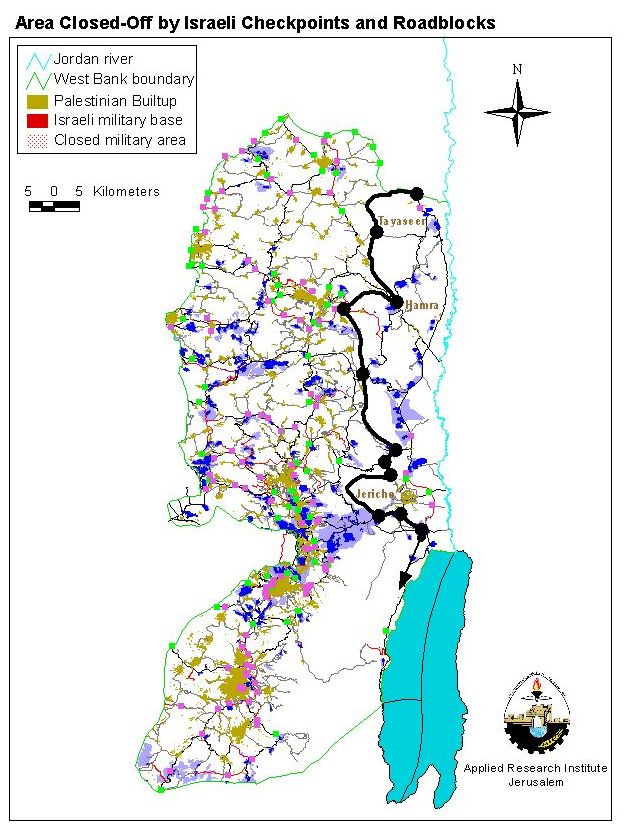
Map 3: Area closed-off by Israeli checkpoints and roadblocks in the Jordan Valley.
Successive Israeli governments had designated the Jordan Valley as one of the priority areas for colonization. The other national priority areas for colonization were: the western parts of the West Bank, the Greater Jerusalem area, and the Etzion Block near Bethlehem. Israel's intention to deprive the Palestinians of the Jordan Valley is further attested by the various proposals it put forward for the final-status map. See for example Sharon's Strategic Interests of 1997 and the Israeli proposal at the final-status talks in May 2000; See Map 4 & Map 5. Note how they both exclude the Jordan Valley from Palestinian areas.
Map 4: Sharon's Strategic Interests
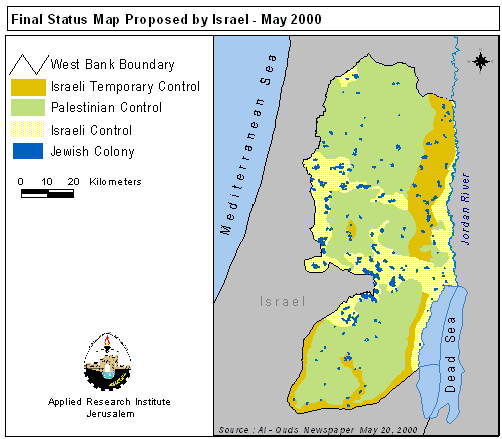
Map 5: Final Status Map Proposed by Israel on May 2000
Research attests that the Israeli government has transferred an amount of 2.2 Billion NIS (new Israeli Shekels) from the Israeli government general budget in favor of the Israeli settlements in the Occupied Palestinian Territories in the year 2001. Following is a summary of the financial incentives and the financial allocations given for the settlers and settlements:
- Incentives given to Israeli settlers NIS200 million,
- The Israeli Settlements Unit: NIS114 million,
- Israeli local Authority budget: The Israeli settlements in the West Bank received from the government NIS618 million,
- Housing budget: The government allocated NIS374 million to help the Israelis to purchase housing units inside the settlements as loans or grants,
- Development and infrastructure budget: The Israeli Ministry of Housing allocated NIS186 million to the settlements,
- Transportation: The Ministry of Transport allocated NIS396 million for the development of roads and infrastructure in the Israeli settlements,
- Development of industrial zones: The Ministry of trade and Industry invested NIS28 million for the development of industrial areas in the settlements,
- Development of water resources: in a framework of a special plan the government transferred NIS41 million to the settlements.
Financing the colonization of Palestine
-
The Israeli government is devoting 1.9 billion dollars from its budget for the settlements for the year 2003,
-
The Keren Keyemetis providing 172.4 million Shekels for the seizure of lands,
-
The ministry of transportation will use 253.5 million shekels from Israeli taxes to pave roads,
-
The ministry of Defense will take the responsibility of opening new bypass roads with a cost of 228 million shekels,
-
The ministry of Commerce & Industry will provide between 22.3 million Shekels and 51.9 million shekels for this sector in the settlements,
-
The Ministry of Housing is providing the settlements with 350 million shekels. Also the ministry is paying 20.6 million shekels for the protection of those settlers who are living in the old neighborhoods of Jerusalem. In addition, the ministry is giving 76.8 thousands Shekels as loans for each person who wants to buy a new apartment where 16.8 thousand shekels of which are grants.
-
The Ministry of Agriculture is participating with 137.8 million shekels for settlements,
-
The Ministry of Religious Affairsis giving 50 million shekels which 30 % of its budget for the building of Synagogues in these settlements,
-
The Ministry of Education is offering the free education for children at the age of 4 years in addition to privileges provided for the teachers working in the settlements schools such as free studies at the university to upgrade their diplomas and levels of higher education, which will cost the ministry 30 million Shekels.
-
The Ministry of Infrastructure is providing 9.7 Million Shekels for water projects,
-
The Ministry of Interior is offering 480 million Shekels for the small settlements and localities, with the privilege of recuperating half million shekels of taxes each year.
Israeli policymakers were well aware of the importance of the Jordan valley and made sure to control it and deprive the Palestinians from this valuable resource, which is so vital to their survival.
Yet, the Israeli Prime minister Ariel Sharon declared in August his intentions to devote 400 million NIS from the Israeli budget at favor of encouraging colonization activities in the Jordan valleys for the year 2003. Since the beginning of the uprising Intifada in 2000, settlers of the Jordan valley rushed out of it seeking security. This devotion came as a financial incentive for settlers to return to settlements of the Jordan valley. Such incentives:
-
Married couples who live in the area for four years are granted a free apartment; besides, one of the couples can receive a free academic scholarship.
-
A grant of 12.000 NIS yearly is given to one of the couples if found out to be working in the Jordan valley.
-
Demand to establish central parks.
-
Demand to lower taxes imposed on settlers.
Finally, the Jordan Valley has also become a target for Israel's infamous separation schemes; See This Link for more details. The Israeli government is planning to build a 'security wall' west of the Jordan Valley to complete the encirclement of the West Bank. The preliminary plans seem to indicate that the wall will reach Maale Efraim settlement but it will most probably go all the way south to Jericho in later phases.
As far as the Palestinians are concerned, Israel has imposed very harsh conditions on them ever since the start of the Al Aqsa Intifada. The Israeli army erected several checkpoints and roadblocks in order to control the movement of Palestinians to and from the Jordan Valley; See Map 3. The area enclosed by this constellation of checkpoints and roadblocks comes to about 900 square kilometers (over 15% of the West Bank area). At these checkpoints, Israeli soldiers do not allow Palestinians to cross if they are not residents of nearby villages. This means that traders, researchers, PNA officials, and the average Palestinian commuters who are simply trying to go from one place to another in the West Bank are all denied the right to enter the area. Israelis enforce this policy by checking the ID cards of Palestinian travelers. If they find out that they are not residents of Jordan Valley villages then the soldiers would tell them to go back from where they came. The soldiers sometimes make exceptions and allow passage of those Palestinians who show documents proving that they are traveling to Jordan and therefore need to use the Jordan Valley road system.
The most notorious of those checkpoints are Hamra and Tayaseer; See Map 3. At these checkpoints Palestinians wait for hours before they can cross. They are interrogated and searched and many are not allowed crossing. In addition, the opening and closing of these checkpoints (or 'gates' as they came to be known) is also not regular. In other words, people often don't know when the 'gate' will be open since opening can be erratic. People often arrive to one of these checkpoints only to find out that it is closed. So they find themselves making several trips to the checkpoint before they succeed in crossing.
Table 2: Palestinian localities in the Jordan Valley
|
Palestinian Locality |
Population 1997 |
|
Aqabat Jaber Refugee Camp |
4581 |
|
Bardala |
1154 |
|
Beit Dajan |
2682 |
|
Ed Dyouk El Tahta |
698 |
|
Ed Dyouk El-Fuqa |
588 |
|
Ein Al Sultan Camp |
1470 |
|
Ein El Bayda |
791 |
|
El Auja |
2896 |
|
Fasayil |
650 |
|
Jericho |
14744 |
|
Jiftlik |
3178 |
|
Khirbet El Maleh |
151 |
|
Khirbet Kardala |
121 |
|
Marj Na'aja |
554 |
|
Marj Na'ajat Izbedat |
968 |
|
Nuwei'ma |
841 |
|
Yanun |
115 |
|
|
|
|
Total |
36182 |
Source: PCBS 1997 Palestinian Census
It is needless to say here that the Palestinians suffer great hardships and humiliation at these checkpoints. The area enclosed by the checkpoints and roadblocks incarcerates over 35000 Palestinians. All these localities, except for Jericho, are small villages that do not have adequate basic services such as health and education. This means they depend on the urban centers for employment, higher education, and health services. Enclosing them in this area means nothing less than cutting them off from their life support system. Except for Jericho, which itself is tightly closed by Israeli checkpoints surrounding it, those villages have very small populations and are hence too small to withstand Israel's harsh policies. It is feared that the continuing strangulation of the Jordan Valley area will choke its residents out of it.
More recently, Israeli authorities have concentrated their colonizing activities in the Jordan valley by targeting its Palestinian population. Following are a set of incidents which occurred this summer:
Table 3: Table of events
|
Date |
Event |
|
May 2003 |
Several landlords in the Jericho area received eviction orders from the Israeli army. Al-Quds |
|
May 21, 2003 |
The IOF built a new outpost in Al Jiftlik valleys and prohibited the residents to enter the area. Al-Quds |
|
July 4, 2003 |
A number of Israeli bulldozers razed 4 dunums of land cultivated with Banana Fruit in El 'Auja and demolished a number of plastic houses in the same area under the pretext of not having building permits. Al-Quds |
|
July 16, 2003 |
Several families were evicted from El Auja and Nuweima villages. Al-Quds |
|
July 23, 2003 |
Israel is planning to erect a 40km Separation Wall in the Jordan valleys which will pass through the Besan valley in the south to reach Ma'ale Efraim settlement in the east and to finally link the northern areas of the Dead Sea. Al-Quds |
|
August 9, 2003 |
Israeli soldiers expelled shepherds from Aqraba, Beit Dajan, and Beit Furik and then set fire to their grazing fields. Al-Quds |
|
August 25, 2003 |
The Israeli soldiers harassed villagers from Ad Duyuk at Tahta area and destroyed their barracks and tents. Al-Quds |
|
September 7, 2003 |
Israeli forces closed the gate at Tayaseer checkpoint thus preventing Palestinians from accessing the Jordan valley. Al-Ayyam |
Source: ARIJ monthly reports at ARIJ Site
As mentioned earlier, the Jordan Valley is of vital importance to the Palestinian economy. The daily harassment and hardships imposed by the Israelis is meant to strangulate the Palestinian communities in the valley. The Israeli authorities hope that these harsh measures will depopulate the valley from its Palestinian inhabitants. In other words, they aim to affect a slow transfer or ethnic cleansing of the area. The current onslaught marks a new and dangerous phase in Israel's attempts to truncate the size of a future Palestinian State and compromise its viability.
Prepared by:
The Applied Research Institute – Jerusalem


